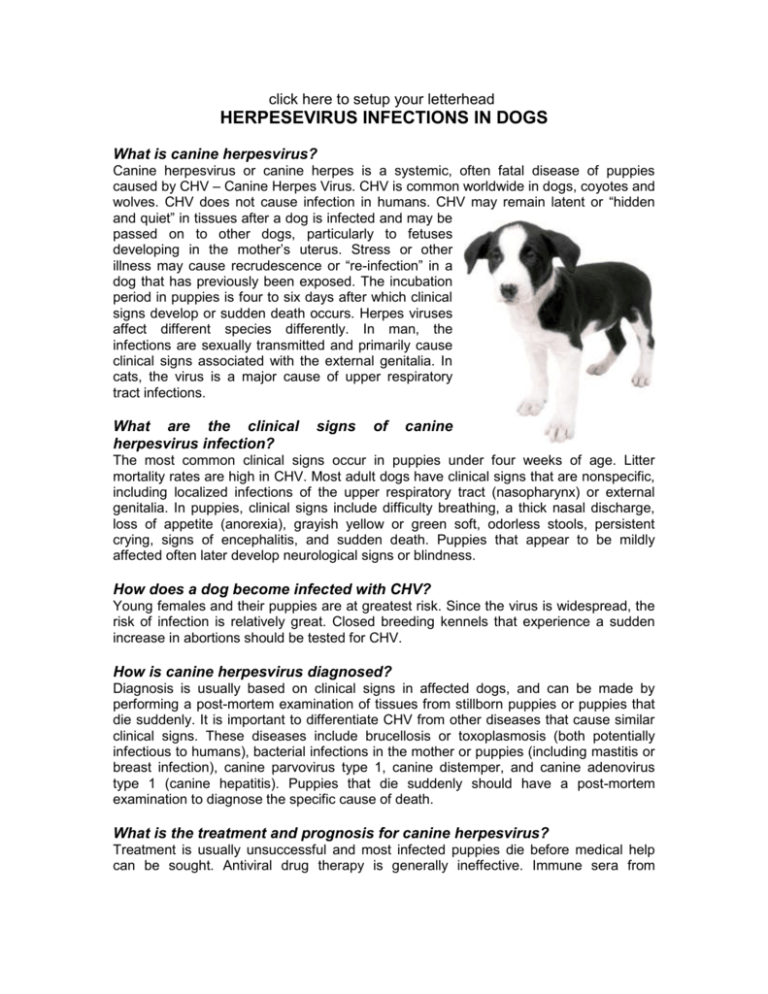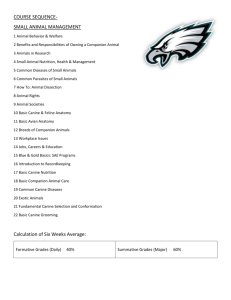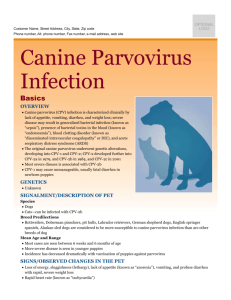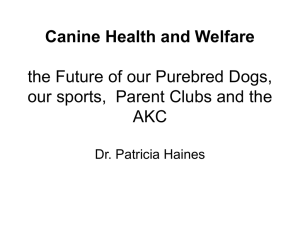HERPESEVIRUS INFECTIONS IN DOGS
advertisement

click here to setup your letterhead HERPESEVIRUS INFECTIONS IN DOGS What is canine herpesvirus? Canine herpesvirus or canine herpes is a systemic, often fatal disease of puppies caused by CHV – Canine Herpes Virus. CHV is common worldwide in dogs, coyotes and wolves. CHV does not cause infection in humans. CHV may remain latent or “hidden and quiet” in tissues after a dog is infected and may be passed on to other dogs, particularly to fetuses developing in the mother’s uterus. Stress or other illness may cause recrudescence or “re-infection” in a dog that has previously been exposed. The incubation period in puppies is four to six days after which clinical signs develop or sudden death occurs. Herpes viruses affect different species differently. In man, the infections are sexually transmitted and primarily cause clinical signs associated with the external genitalia. In cats, the virus is a major cause of upper respiratory tract infections. What are the clinical herpesvirus infection? signs of canine The most common clinical signs occur in puppies under four weeks of age. Litter mortality rates are high in CHV. Most adult dogs have clinical signs that are nonspecific, including localized infections of the upper respiratory tract (nasopharynx) or external genitalia. In puppies, clinical signs include difficulty breathing, a thick nasal discharge, loss of appetite (anorexia), grayish yellow or green soft, odorless stools, persistent crying, signs of encephalitis, and sudden death. Puppies that appear to be mildly affected often later develop neurological signs or blindness. How does a dog become infected with CHV? Young females and their puppies are at greatest risk. Since the virus is widespread, the risk of infection is relatively great. Closed breeding kennels that experience a sudden increase in abortions should be tested for CHV. How is canine herpesvirus diagnosed? Diagnosis is usually based on clinical signs in affected dogs, and can be made by performing a post-mortem examination of tissues from stillborn puppies or puppies that die suddenly. It is important to differentiate CHV from other diseases that cause similar clinical signs. These diseases include brucellosis or toxoplasmosis (both potentially infectious to humans), bacterial infections in the mother or puppies (including mastitis or breast infection), canine parvovirus type 1, canine distemper, and canine adenovirus type 1 (canine hepatitis). Puppies that die suddenly should have a post-mortem examination to diagnose the specific cause of death. What is the treatment and prognosis for canine herpesvirus? Treatment is usually unsuccessful and most infected puppies die before medical help can be sought. Antiviral drug therapy is generally ineffective. Immune sera from recovered females may be beneficial in reducing puppy deaths if it is administered before the onset of illness. How can I prevent CHV? The disease may be prevented by avoiding contact with infected dogs. This is particularly important for pregnant females. There is currently no vaccine available in the United States or Canada. In Europe, a vaccine is available but has thus far demonstrated variable responses. Good hygiene has been proven to dramatically reduce deaths in puppies. Adult dogs that are infected often have a short duration of clinical signs and recover without medical intervention. However, these adult dogs often develop latent infections (or become carriers) and may periodically shed and spread the virus throughout their lives. CHV is most dangerous to young and developing puppies. In these cases, death is unfortunately the most common outcome. This client information sheet is based on material written by Ernest Ward, DVM. © Copyright 2005 Lifelearn Inc. Used with permission under license. February 12, 2016







